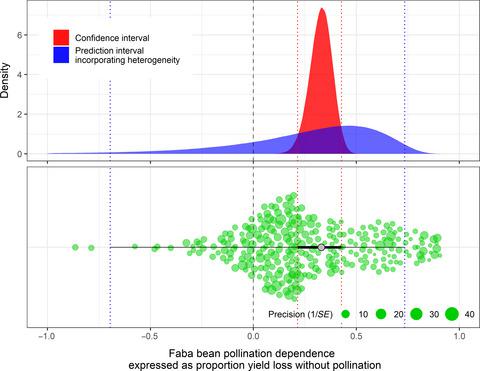当前位置:
X-MOL 学术
›
J. Appl. Ecol.
›
论文详情
Our official English website, www.x-mol.net, welcomes your feedback! (Note: you will need to create a separate account there.)
Quantifying crop pollinator dependence and its heterogeneity using multi‐level meta‐analysis
Journal of Applied Ecology ( IF 5.7 ) Pub Date : 2020-12-27 , DOI: 10.1111/1365-2664.13830 Jacob Bishop 1 , Shinichi Nakagawa 2
中文翻译:

使用多级荟萃分析量化作物授粉媒介的依赖性及其异质性
更新日期:2020-12-27
Journal of Applied Ecology ( IF 5.7 ) Pub Date : 2020-12-27 , DOI: 10.1111/1365-2664.13830 Jacob Bishop 1 , Shinichi Nakagawa 2
Affiliation

|
- Biotic pollination can benefit crop production, but its effects are highly variable. To maximise benefits from this ecosystem service, we need a greater understanding of the factors that cause variation so that ecological intensification can be more effectively applied.
- We focus on understanding the benefits of pollination to faba bean Vicia faba. We use a literature review followed by multi‐level meta‐analysis to estimate overall benefits of pollination to faba bean yield and to quantify variation (heterogeneity) in these benefits associated with different contextual factors (e.g. plant genotype, growing environment).
- Our overall estimate of pollination benefit to faba bean yield, expressed as the percentage yield reduction without pollination, is 32.9% (confidence interval: 21%–43%). Based on the prediction intervals, which include the heterogeneity in pollination benefit, there is an 80% chance that pollination will increase yield of a faba bean crop.
- Half of all heterogeneity in pollination dependence was due to differences between plant genotypes. The number of beans per plant showed similar pollination dependence to yield mass per plant while pod number and number of beans per pod underestimated yield benefits. There was weak evidence to suggest pollination benefits vary between pollinator species, with honeybees showing a smaller yield increase.
- Differences in the experimental method used to assess pollination benefit did not significantly affect the estimate, including the growing environment, measurement scale, or whether the effects of experimental pollinator enclosures were controlled. This suggests that simplified experimental studies comparing yield of open‐pollinated and enclosed plants can provide reliable insights into pollination benefits across a large range of plant genotypes and landscapes.
- Synthesis and application. We found high variability in pollination benefits both between and within publications in our meta‐analysis. Plant genotype, how yield was measured, and pollinator species affected the level of pollination benefit. Despite variability in pollination benefits due to various contextual factors (both inside and outside of grower control), there is a high likelihood that biotic pollination will increase faba bean yield. Our findings support ecological intensification and specifically the management of pollinators to maximise pollination benefits to faba bean production.
中文翻译:

使用多级荟萃分析量化作物授粉媒介的依赖性及其异质性
- 生物授粉可以使作物生产受益,但其影响却千差万别。为了从这种生态系统服务中获得最大收益,我们需要对引起变化的因素有更深入的了解,以便可以更有效地应用生态集约化。
- 我们专注于了解授粉对蚕豆野豌豆的好处。我们使用文献综述,然后进行多级荟萃分析,以估算授粉对蚕豆产量的总体收益,并量化与不同背景因素(例如植物基因型,生长环境)相关的这些收益的变异(异质性)。
- 我们对蚕豆产量的授粉效益的总体估计为32.9%(置信区间:21%–43%),表示为不授粉的单产减少百分比。根据预测间隔(包括授粉效益的异质性),授粉有80%的机会增加蚕豆作物的产量。
- 授粉依赖中所有异质性的一半归因于植物基因型之间的差异。每株植物的豆子数量显示出与授粉相关的相似性与每株植物的产量,而荚果的数量和每荚果的豆子数量却低估了产量收益。证据不足,表明授粉媒介之间的授粉效益有所不同,蜜蜂的单产增加幅度较小。
- 用于评估授粉效益的实验方法的差异并没有显着影响估计值,包括生长环境,测量规模或是否控制了授粉媒介罩的影响。这表明简化的实验研究比较了开放授粉植物和封闭传粉植物的产量,可以提供可靠的见解,了解各种植物基因型和景观的授粉效益。
- 综合与应用。我们在荟萃分析中发现出版物之间和内部的授粉效益差异很大。植物基因型,如何测量产量以及授粉媒介种类影响授粉效益水平。尽管由于各种环境因素(在种植者控制的内部和外部),授粉收益的可变性,但生物授粉有很大可能增加蚕豆的产量。我们的发现支持生态集约化,特别是授粉媒介的管理,以最大限度地提高对蚕豆生产的授粉效益。



























 京公网安备 11010802027423号
京公网安备 11010802027423号